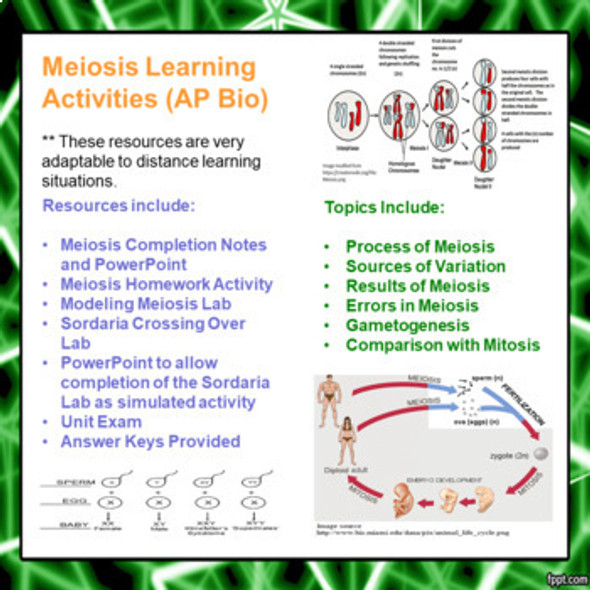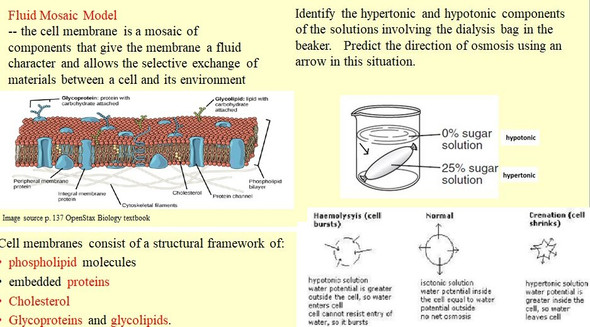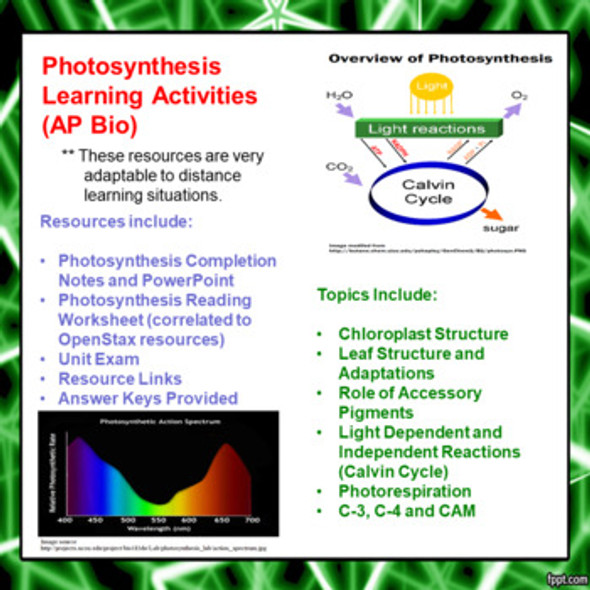Cell Respiration/Thermoregulation Learning Activities for AP Biology (Distance Learning)
- Bulk Pricing:
- Buy in bulk and save
- Contributor:
- Monday's Rescue
- Grade Level:
- 9-12
- Product Type:
- Learning Package (Notes, PowerPoint, Lab, Homework)
- File Type:
- doc, pdf, ppt
- Pages:
- 47
- Answer Key:
- Yes
Description
This package of learning materials addresses topics taught in AP Biology or other upper level biology classes on the topic of cellular respiration and introduction to aspects of thermoregulation. Some of the topics addressed pertaining to cellular respiration include glycolysis, transition reaction, Krebs cycle, electron transport chain/chemiosmosis, control of oxidative phosphorylation, efficiency of cell respiration, lactic acid and ethyl alcohol fermentation. Thermoregulation topics addressed include endothermy, ectothermy, diapause, countercurrent circulation and structural and molecular adaptations to regulate temperature. The specific learning objectives and standards are addressed at the end of the package description. This unit has been correlated to the new 2019-2020 AP Biology ETS, NGSS and Common Core learning objectives/standards.
All materials are may be modified by you to suit your needs and those of your students. Documents are available in both word and pdf format. Many of these materials may suitable for use in a flipped classroom.
The file contains 47 pages of student learning materials and one 56 slide PowerPoint.
The answer keys to all activities and the nervous test are included.
The specific contents of the learning package includes the following items (the page count for these items are actual student handouts as answer key page counts are not included):
--Learning Goals, NGSS Correlations, ETS AP Biology and Common Core Learning standards correlations (2 pages)
-- Cell Respiration and Aspects of Thermoregulation Completion Notes (16 pages)
-- PowerPoint to accompany the Cell Respiration and Aspects of Thermoregulation Completion Notes (59 slides)
-- Cell Respiration Reading Worksheet (correlated to the free Openstax Biology text but can be used with other information sources) (11 pages/45 short answer questions)
-- Links to other web based Cell Respiration Free Online Resources (2 pages)
-- Cell Respiration Exam (50 multiple choice and modified true-false questions) (6 pages)
-- Alternative Cell Respiration Lab Activity (11 pages)
ETS Learning Objectives
Enduring Understanding
ENE-1 The highly complex organization of living systems requires constant input of energy and the exchange of macromolecules.
Learning Objectives
ENE-1.H Describe the role of energy in living organisms.
ENE-1.K Describe the processes that allow organisms to use energy stored in biological macromolecules.
ENE-1.L Explain how cells obtain energy from biological macromolecules in order to power cellular functions.
Cellular Respiration and Thermoregulation Learning Goals (local)
Upon the completion of the reading and discussion of this material the student will be able to:
1. discuss the role of ATP/ADP in the energy economy of living organisms.
2. recognize that energy may be converted from one form to another and that no energy conversion is 100% efficient.
3. explain the difference between aerobic and anaerobic respiration.
4. compare the efficiency of aerobic and anaerobic respiration.
5. explain why most organisms need oxygen and state how carbon dioxide and water are produced as waste products of cellular respiration.
6. name the starting materials and important end products of; glycolysis, the transition reaction, TCA cycle, and the electron transport system.
7. discuss the functions of the processes above in the scheme of cellular respiration.
8. state where in the cell and/or mitochondrion the processes listed in objective number seven occur in eukaryotes.
9. explain the importance of the electron transport system to the cell.
10. describe the chemiosmotic theory of ATP synthesis.
11. explain how the ability to undergo anaerobic respiration, and to acquire an oxygen debt, is a useful adaptation for muscle tissue.
12. compare and contrast the process of alcoholic fermentation by yeast with the process of anaerobic respiration by a muscle.
13. compare aerobic and anaerobic respiration with respect to the amount of ATP generated by each process.
14. discuss some ways living things maintain temperature homeostasis.
NGSS Standard
HS-LS1-7. Use a model to illustrate that cellular respiration is a chemical process whereby the bonds of food molecules and oxygen molecules are broken and the bonds in new compounds are formed resulting in a net transfer of energy.
Common Core State Standards Connections:
ELA/Literacy
RST.11-12.1 Cite specific textual evidence to support analysis of science and technical texts, attending to important distinctions the author makes and to any gaps or inconsistencies in the account.
WHST.9-12.2 Write informative/explanatory texts, including the narration of historical events, scientific procedures/ experiments, or technical processes.
WHST.9-12.5 Develop and strengthen writing as needed by planning, revising, editing, rewriting, or trying a new approach, focusing on addressing what is most significant for a specific purpose and audience.
WHST.9-12.7 Conduct short as well as more sustained research projects to answer a question (including a self-generated question) or solve a problem; narrow or broaden the inquiry when appropriate; synthesize multiple sources on the subject, demonstrating understanding of the subject under investigation.
WHST.9-12.9 Draw evidence from informational texts to support analysis, reflection, and research.
Mathematics
MP.4 Model with mathematics.
Terms of Use
Purchase of the product is for classroom use by the purchaser only. It is a violation for individuals, schools, and districts to redistribute, sell, or post this item on the Internet.
This work is licensed under a Creative Commons Attribution-NonCommercial-ShareAlike 4.0 International License.






















